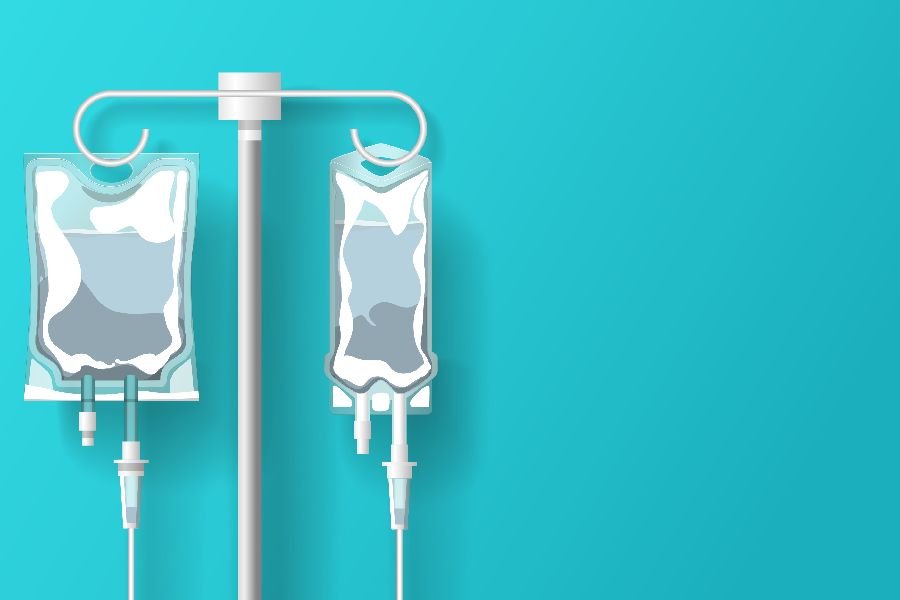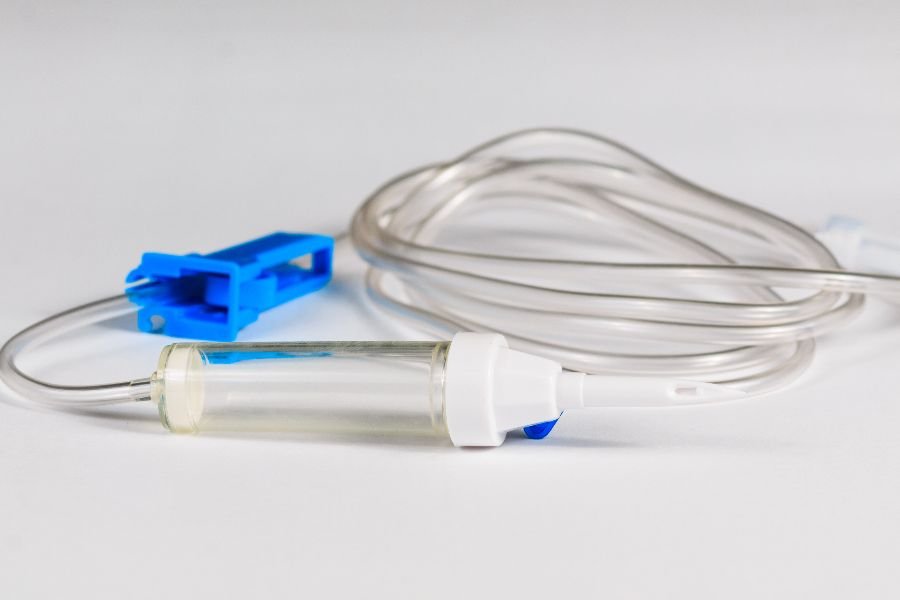Intravenous therapy is a revolutionary medical technique invented over half a century ago. We can learn a lot about modern medicine by digging deeper into the history of IV therapy.
The development of IV therapy is of significant importance. Not only does it give us a detailed overview of the treatment, but it also gives us proof of how quickly medicine can change.
Let’s go through the historical background of IV therapy, so you can discover how it started saving people’s lives and how it became such an important treatment.
Timeline of IV Therapy: Short Overview
| 1492 | First unsuccessful human-to-human blood transfusion |
| 1656 | The invention of the first IV therapy device |
| 1656 | First successfully administered intravenous therapy on an animal |
| 1666 | First animal-to-animal blood transfusion |
| 1667 | First animal-to-human blood transfusion |
| 1829 | First successful human-to-human blood transfusion |
| 1832 | Saline infusion was used for cholera patients |
| 1845 | The hollow needle was perfected |
| 1852 | The modern hypodermic syringe was created |
| The late 1890s | Oxygen was intravenously administered |
| Quinine intravenous injections were used for severe cases of malaria | |
| Quine hydrochlorate solution was administered through IV for syphilis | |
| 1896 | Invention of the Luer connector |
| 1930 | IV fluids started being stored in glass bottles |
| 1940 | Nurses were allowed to administer IV therapy |
| 1950 | The Massa or Rochester Plastic Needle was introduced |
| 1970 | Vitamins and minerals were administered intravenously for the first time |
| Invention of the ambulatory infusion pump |
History of IV Therapy: The Early Beginnings
The concept of IV therapy was born in the late Middle Ages. During this time, there were a lot of firsts for the new medical invention, from human-to-human blood transfers to IV therapy performed on animals and blood transfers between animals and humans.
The first intravenous therapy performed on humans
The beginnings of intravenous therapy in the healthcare industry go back to 1492. The first IV treatment was a blood administration from three donors to the patient.
The first intravenous treatment was given to the head of the Catholic Church of the time, Pope Innocent VIII. The Pope’s doctor performed IV therapy on him after he suffered from an apoplectic stroke and fell into a coma.
To try and save the Pope, the doctor took blood from three healthy young individuals and administered the fluids to the Pope via IV therapy.
Unfortunately, the attempt to save the Pope’s life was unsuccessful. Along with the Pope, the three young boys who donated their blood passed away.
With such unfortunate results from the first IV therapy, medical professionals didn’t use the treatment for over a century. Hence, there was no room for the progression of the IV inventions until the mid-1600s.

Source: shutterstock.com/ Photo Contributor: ivector
The ivention of the first infusion device
The infusion devices, as we see them today, look simple and easy to get a hold of. Yet, the evolution of IV therapy took some time and many unsuccessful attempts to get to where it is now.
Sir Christopher Wren started writing the history of IV catheters when he made the first infusion device.
In 1656, an Oxford scientist used a pig’s bladder and a writing quill to make an IV device. The pig’s bladder was used as a bag for the fluid, while the quill was inserted into the patient’s vein.
IV infusion on animals
Christopher Wren and Robert Boyle
If you wonder who invented IV therapy, the answer is Christopher Wren. It is important to note he had help from Robert Boyle. However, Boyle fully attributed the authorship to Wren.
The two scientists performed the first successful intravenous therapy on a large dog in 1656.
The first intravenous injection was given in Oxford, United Kingdom, on High Street. To report the experiment, Sir Christopher Wren wrote a letter and stated: “I Have Injected Wine and Ale in a liveing Dog into the Mass of Blood by a Veine, in good Quantities, till I have made him extremely drunk, but soon after he Pisseth it out.”
The scientist used the IV device to infuse antimony, wine, opium, and ale directly into the dog’s veins. The VI treatment made the dog drunk, but he survived.
Wren and Boyer continued with their research and performed IV infusions with other fluids. During the experiments, Wren and Boyer faced difficulties with the equipment.
They figured out that the materials of the IV infusion device didn’t serve their purpose. The writing quills were too fragile to work with, making the procedure even harder than it was.
Richard Lower
Another important name in the history of IV therapy is Doctor Richard Lower, also from Oxford. Lower became popular by transfusing blood from one animal to another in 1666. Unfortunately, Lower’s experiment wasn’t successful.
Learning from his colleagues’ mistakes, Lower made IV infusion devices from silver.
Later, Lower collaborated with Edmund King for a transfusion of animal blood into a human. In 1667, the two scientists transfused sheep’s blood into Arthur Coga. The transfusion was performed in front of the Royal Society. Sadly, the patient passed away.
Jean Baptiste Denis
Jean Baptiste Denis tried to cure illnesses and prolong people’s lives by inserting animal blood. Denis and Paul Emmerez did experiments for less than a year, from June 1667 to January the following year.
Denis’s study was focused on taking out blood from the animal’s carotid arteries and injecting it into human patients. For the experiments, he used blood from calves, baby goats, and lambs.
Jean Baptiste Denis did the first successful xenotransfusion on a 15-year-old boy. The patient had a chronic fever and was given eight ounces of lamb blood. After the transfusion, the boy felt better.
The success of xenotransfusion encouraged Denis to continue with his study. Denis’s IV infusion experiments had two human casualties, and three people were allegedly cured.
Consequences of the IV infusion experiments in the Middle Ages
After these events, France and England banned blood transfusion from animals to men. Xenotransfusion was considered dangerous because the authorities believed it could make changes in our species. Additionally, the Vatican issued a decree forbidding xenotransfusion.

Source: shutterstock.com/ Photo Contributor: ivector
IV Therapy in the 18th Century
The ban on performing blood transfusions didn’t stop the evolution of IV therapy. Instead, the scientists continued to seek ways to make progress. The “Father of American Surgery”, Dr. Philip Syng Physik, encouraged human-to-human blood transfusions.
Motivated by him, Dr. James Blundell came up with the idea to do blood transfusions on new mothers. Many of Blundell’s patients were dying during childbirth. Consequently, he tried to treat the postpartum hemorrhage with intravenous therapy.
Blundell used a syringe to take out blood from the arm of the patient’s husband. Then, he transfused four ounces of blood into the new mothers. Blundell had the honor of doing the first successful human-to-human blood transfusion in 1829.
He did a total of 10 blood transfusions with a 50% success rate.
Blundell used many different instruments for blood transfusion, like the impellor and the gravitator. His inventions and discoveries are used today and have greatly influenced modern medicine.
One of his greatest discoveries during his medical work is that letting the air out of the syringe before transfusing liquids is of significant importance. Today, nurses and doctors still let the air out before they push the needle into the skin.
Evolution of IV Therapy in the 19th Century
Transfusions and injections started to be more often used in the early to mid-19th century. The cholera outbreaks in Europe speed up the evolution of IV therapy.
As Dr. WIlliam Brooke O’Shaughnessy was studying the implications of the cholera disease on humans in 1831, he discovered that the patient’s blood lacked water and saline.
One year later, Dr. Thomas Latta used the findings of O’Shaughnessy and started treating cholera patients with intravenous saline. Latta revolutionized intravenous therapy with the type of liquid he used.
Interestingly enough, Latta did his first salt solution administration rectally. Later, in May 1832, he informed the Central Board of Health that he would start treating patients with intravenous saline treatment.
The results of Latta’s saline administration weren’t consistent because he wasn’t sure about the right saline measurements. Unfortunately, most of the patients Latta has treated died. Still, his work is a huge part of the IV infusion development.
Guido Baccelli
During the last decade of the 19th century, Guido Baccelli published a study about the IV therapy. He is especially known for administering oxygen intravenously and prolonging the life of the Italian King then, Victor Emmanuel II.
Additionally, he discovered that quinine intravenous injections could help with severe malaria cases. Baccelli also used quine hydrochlorate solutions for syphilis cases.
The Luer connector
The end of the 19th century was concluded with the invention of the Luer connection, which we still use today. The Leuer connector was made by the instrument maker Karl Schneider in Paris.
The instrument was designed as a leak-free connection between the parts of the IV therapy in 1896. The two main components of the Luer connector are the glass cylinder and the plunger.
Development of IV apparatus
The development of the modern IV apparatus started with the hollow needle and the syringe in the mid-19th century.
Francis Rynd is a surgeon who perfected the hollow needle around 1845. Seven years later, Alexander Wood invented the modern hypodermic syringe.
It is important to note that the origins of syringes date back to the 5th century BC. Then, there were syringes with compressed bulbs. Years later, the history of the IV therapy apparatus records the use of piston and barrel syringes (180 BC) and metal syringes (16th century).
Before the invention of the Massa (Rochester Plastic Needle), intravenous fluids were administered by using three methods:
Vein cutdown,
Hollow metal needles, and
Threading plastic tubing into veins.

Source: shutterstock.com/ Photo Contributor: Siberian Art
The 20th Century as a Crucial Period in the Evolution of IV Therapy
In the early 20th century, intravenous infusion was not fully developed. It was in the 1960s when it started to be widely used as a medical treatment.
In the first 20 years of the 20th century, the fluids that should be typically administered intravenously today were given to the patients as a Murphy drip. In simple terms, the nutrition needs of the patient were administered rectally.
Robert Elman
Robert Elman is an important figure in the history of IV therapy which focused on proving the importance of parenteral hyperalimentation. In 1948, a clinical surgery professor discovered that it is beneficial for patients to get amnio acids intravenously.
John Myers
In 1970, the internist from the John Hopkins Hospital in Baltimore, Dr. John Myers, started practicing intravenous infusions of vitamins and minerals. He wanted to discover whether an IV cocktail could boost the immune system.
Firstly, Myers tested the IV cocktails with vitamins and minerals on animals. Later, he administered the first IV therapy to himself. Since then, millions of people have used IV therapy to get the nutrients they need.
Dean Kamen
The latest important invention in the history of infusion pumps is the ambulatory infusion pump. For that, we should thank Dean Kamen, who made it easier for patients to receive injections in their beds with the wearable pump.
Development of IV Infusion
Storing IV therapy
IV infusions have been stored in different ways. At the beginning of the 19th century, IV fluids were kept in a container covered with gauze.
Later on, in 1930, the containers were replaced with vacuum-sealed glass bottles. Today, IV infusions are put in plastic bags as a cheaper, more practical alternative to glass bottles.

Source: shutterstock.com/ Photo Contributor: imagestockdesign
History of IV fluid therapy administration
The medical personnel with the authority to administer IV therapy has also changed. In the beginning, the medical treatment was only done by doctors.
Nowadays, administering an IV treatment is mainly a nurse’s job. This IV therapy milestone of nurses administering IV therapy happened in the early 1940s.
How is IV Therapy Used Today?
IV therapies are popular medical treatments in the US. Intravenous infusions are administered every day in hospitals worldwide. Typically, IV is used by medical professionals to give the patients blood, medication, vitamins, and other therapeutic fluids.
Mobile IV therapy services like The Drip Infusion also provide cocktail solutions for everybody who wants to enhance their overall health and wellness. The cocktail menu includes solutions that might help with dehydration, sickness, hangover, morning sickness, weight loss, etc.
Conclusion
The journey of IV therapy started with a lot of unsuccessful experiments. However, that didn’t stop the masterminds from researching the topic. We must thank those brave scientists and patients for the revolutionary intravenous therapy.
Today, IV therapy is one of the most important parts of modern medicine. It plays a huge role in medical treatments and helps improve people’s health worldwide. We have a lot to learn from the history of IV therapy on how to make it even better in the future and make people’s lives easier.




